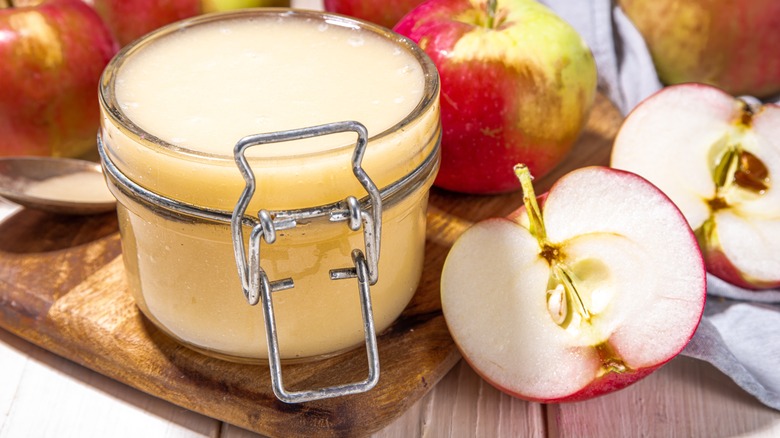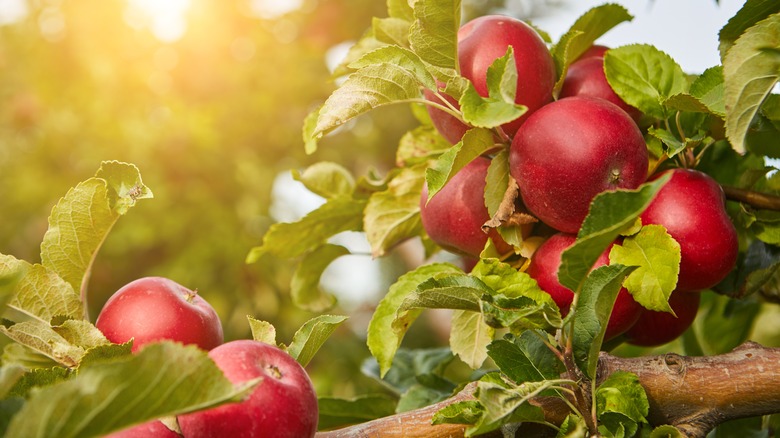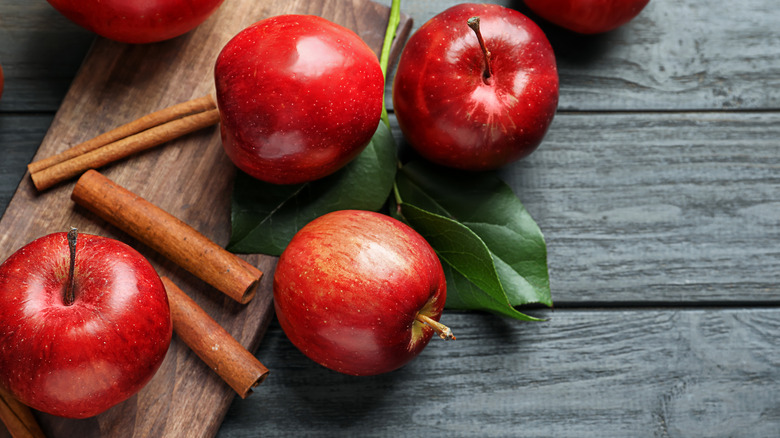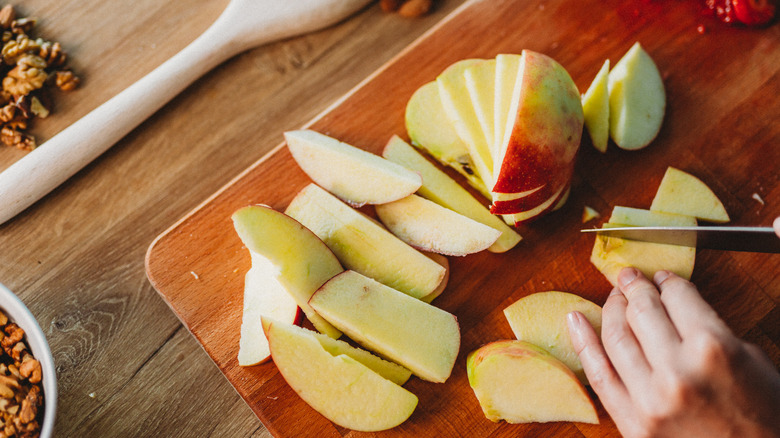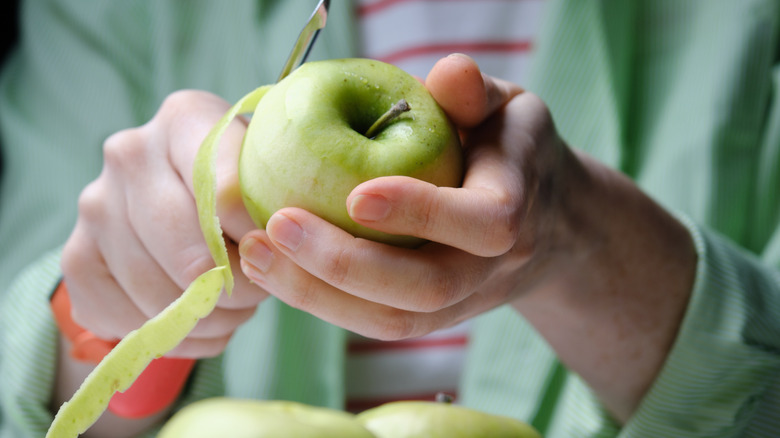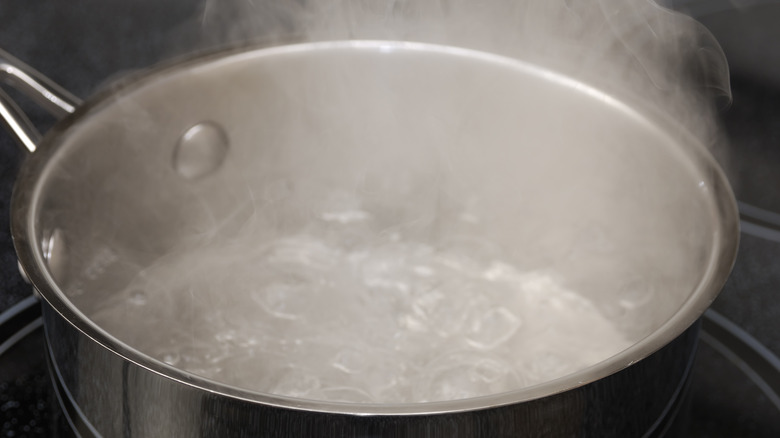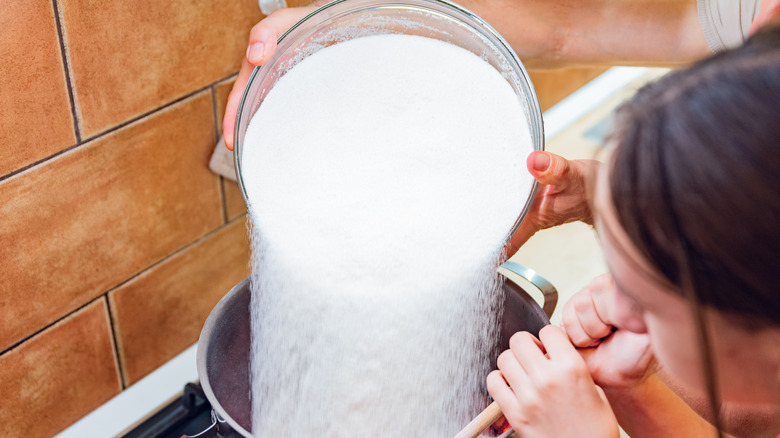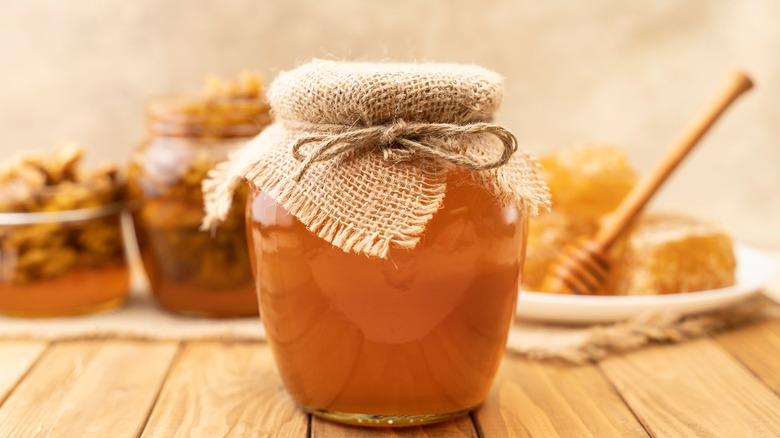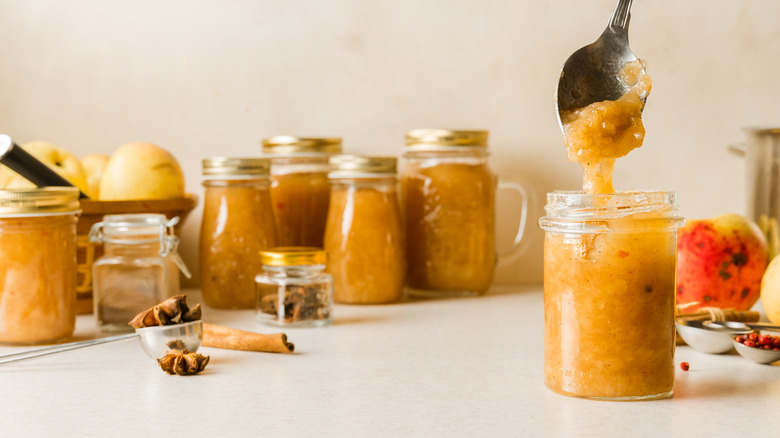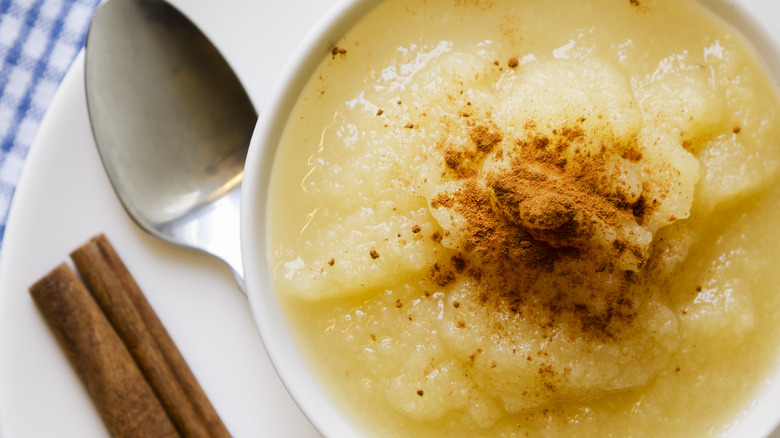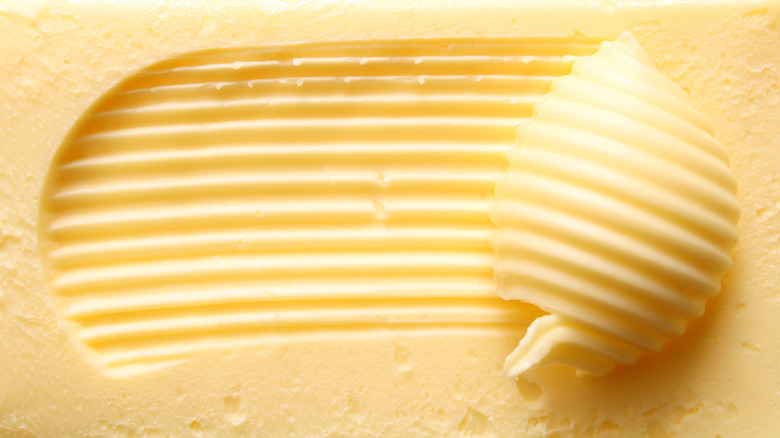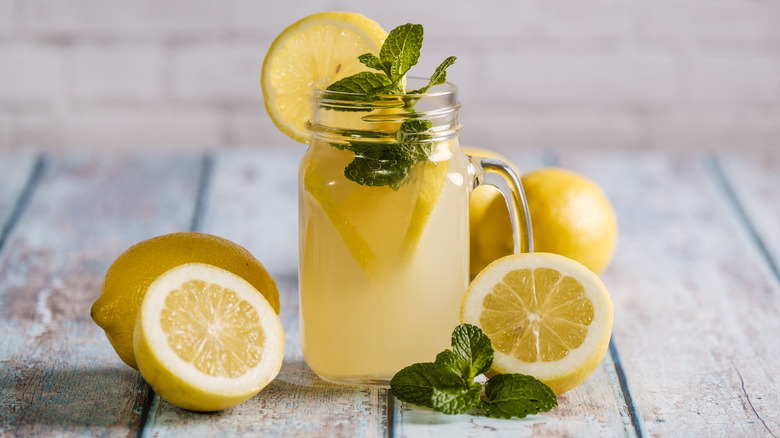12 Tips You Need For Making Applesauce
Smash an apple, make applesauce — if only it were quite that simple. Like much in life, the best things take time. Applesauce is no different. It's not as easy as going to a supermarket and picking out the freshest, unbruised apples. To say nothing of types of apples. Planning must take place. Preparations must be made. Are you in the mood for something chunky or creamy, festive or simple, savory or sweet?
Navigating the world of applesauce feels a bit like an apple maze or, given the season, like we're bobbing for apples with a mask on virtually impossible. Once you've welcomed the challenge, it becomes less of an act of frustration and one more focused on curating a flavor experience. You see, not all apples are created equal. Nor are all methods created equal. Things that might be overlooked by first-time applesauce makers can make all the difference. Though a simple treat from your more innocent years, applesauce can mature into something of a fine dining experience, but there remains much to consider.
Choose the freshest apples
New-crop apples, those that are fresh from the orchid and not stored for off-season sale, are hard to come by. The decision to choose, say, a Granny Smith apple over a Gala, or a Braeburn over a Golden Delicious, is entirely up to you and your seasonal availability. The best advice for optimal flavor? Grab your apples from the farmer's market, nearby specialty grocer, or pick-your-own orchard.
These spots often source produce locally, ensuring freshness and peak flavor. And remember, the journey to the perfect applesauce isn't just about the type of apple; it's about its quality. Every apple has a history, and a freshly picked apple, still crisp from the tree, holds its flavor, texture, and moisture content better than one that's been stored for weeks. Supermarket apples, often months old, are stored in controlled atmosphere conditions to delay ripening. Over time, starches convert to sugars, impacting flavor; they lose moisture, which affects crispness. As an apple ages, its skin wrinkles, the flesh softens, and its taste diminishes, veering from tart to bland. Along with creases in the skin, look for brown, bruised spots and, on farm-fresh apples, any sign of worms or bugs. You can cut around some things, but it's better to aim for fresher apples when making your sauce.
Think hard about your apple types
In the pursuit of applesauce excellence, choosing the right apple is imperative — it sets the fundamental component for the final act. A Granny Smith offers a sharp, invigorating tartness, perfect for those who seek a zesty zing in their sauce. Venture towards a Honeycrisp apple, and you'll be rewarded with a lush, mellow sweetness, like a gentle autumn breeze. With the quantity of apples you need for making sauce, it's likely you'll buy bulk apples of the same type, and that's perfectly fine.
However, making apple sauce can also be culinary alchemy. Since each apple variety brings its personality to the pot — the robust Jonagold, the spicy Braeburn, or the classic McIntosh, the key is to experiment and consider mixing apple types. Try playing with the orchard's bounty until the taste transcends the sum of its parts. Harmonizing the unique notes of multiple varieties is as much about intuition as it is about flavor. The differences are subtle, and there's no real way to go wrong.
For a well-rounded flavor and varied texture, mix the more mealy and thin-skinned Golden Delicious with a tart or firm apple variety, like Fuji. Similarly, a crisp but relatively neutral Braeburn can be accentuated by the blushing botanical sweetness of a Pink Delicious. Every apple has a story, and in your sauce, they can come together to tell a tale of taste that is uniquely yours.
The way you chop determines texture
Depending on personal (or household) preference, you may desire a thicker, chunkier sauce or its opposite. Chopping your apples into small bits will inevitably yield a creamier sauce. Use thicker slices, and cook for half the time, and you'll have a sauce that feels and tastes heartier. Michelin-starred chef and host of "Hell's Kitchen" Gordon Ramsay says thinly sliced apples carved moments before placing in the sauce keeps the flavors alive. Cutting apples prematurely before cooking can lead to oxidation, which dulls their flavor and alters their texture, making them mealy and less vibrant in taste. Additionally, exposure to air can cause browning, detracting from their fresh, crisp appeal.
Taking a cue from Ramsay's advice, the timing of the cut can truly enhance the vitality of the dish. Freshly cut apples retain more of their natural juices, ensuring that the inherent sweetness and tartness of the fruit aren't lost during the cooking process.
Using this knowledge, you can play with combinations to achieve your ideal applesauce consistency. Want a mix of creamy and chunky? Try a blend of finely chopped apples with a handful of thicker slices. There are many ways to add flavor to applesauce, which allows for endless experimentation, making it a fun and ever-evolving dish in your culinary repertoire.
Use peels to provide greater nutrients
Maybe it seems lazy, but keeping the peels on your apples actually adds extra nutrition and fiber. According to the U.S. Department of Agriculture's National Nutrient Database, a medium unpeeled apple has "nearly twice the fiber, 40 percent more vitamin A and 25 percent more potassium than a peeled apple." And the good news doesn't stop there.
Independent studies conducted by the University of Iowa, the University of Maryland Medical Center, and Cornell University state that apple skins also contain ursolic acid (which helps burn fat), quercetin (an anti-inflammatory), and triterpenoids (a potentially cancer-blocking compound). Thanks to these studies, we know that apple skins are perhaps worth keeping.
The peel also contains a variety of phytochemicals, those naturally occurring compounds that can help ward off a range of diseases and promote overall health. Antioxidants, which combat damage-causing free radicals in the body, are found in abundance in apple skins. Not to mention, the peels provide a richer texture and a nuanced depth of flavor to your applesauce, churning out a more rustic and authentic taste. Beyond the nutritional boost, keeping the peels can also save time in the kitchen. Less prep means getting to the cooking and enjoying part faster. It's a nod to the age-old principle of using food in its entirety, minimizing food waste, and maximizing nutritional benefits.
Boil slow, not fast
In applesauce making, the ideal cooking duration hinges on a low and slow approach. Aim for a gentle simmer, not a vigorous boil, which typically lasts about 20 to 30 minutes. This simmering point is crucial — it's lower than boiling, marked by small bubbles and a temperature around 185 F, compared to a boil's full, rolling bubbles at 212. This subtle difference in temperature allows the apples to cook thoroughly without disintegrating too rapidly and losing their nuanced flavors.
When using alternative cooking methods like a pressure cooker or slow cooker, the temperature dynamics shift. In a pressure cooker, the applesauce cooks under high force, reducing the cooking time significantly — often just about 5 to 10 minutes. A slow cooker, conversely, extends the cooking process, usually requiring several hours on a low setting. Both methods have their merits: the pressure cooker for its speed and the slow cooker for its ability to deeply meld flavors over time. Regardless of the method, monitoring the texture and tenderness of the apples is key. They should be soft enough to mash easily yet not so overcooked that they lose all structure. A careful watch, occasional stirring, and adjustments in cooking time are your allies in achieving applesauce perfection.
Know the importance of when to add sugar
The art of making applesauce isn't just about mixing ingredients; it's about understanding the perfect timing for adding sugar, a process deeply intertwined with osmosis. The ideal time to add sugar is when the apples have started to soften and release their natural juices. This stage typically occurs as the apples simmer and soften but before they become fully mushy. At this point, the sugar can evenly disperse and interact effectively with the apple's moisture, enhancing the osmotic process. The sugar draws out the water from the apple cells, intensifying the sauce's flavor and texture.
The type of sugar you use can indeed influence the overall result. While granulated white sugar is common, using brown sugar, demerara, or even honey can add a richer, more complex flavor. The choice of sugar can subtly affect the timing of addition; for example, liquid sweeteners like honey might be added slightly later as they blend more readily with the apple mixture. The key is to ensure that whatever sugar you choose is incorporated at a point where it can best enhance the apples' natural sweetness without overpowering it.
Sweeten without sugar at all
In the realm of applesauce, moving away from refined sugar opens up healthier and tastier avenues. Honey, renowned for its natural sweetness and antioxidant properties, is an excellent alternative. When substituting honey for sugar, a general rule is to use about ½ or ⅔ cup of honey for every cup of sugar due to its higher sweetness intensity. This adjustment not only sweetens but also adds a distinct flavor profile to your applesauce, infusing it with a subtle floral note that complements the apple's natural flavors.
Coconut sugar offers a subtle caramel-like taste. This natural sweetener, derived from the sap of coconut trees and their blossoms, can be used in a one-to-one ratio with regular sugar. Its coarser texture may require a bit of processing for smoother integration, but it brings a delightful depth to the applesauce. The gentle equatorial undertones of coconut sugar pair exquisitely with the tartness of the apples, creating a flavor harmony that elevates the traditional applesauce experience. Opting for these natural sweeteners not only enhances the health benefits but also adds a gourmet twist to this classic dish, making it a versatile and sophisticated addition to any meal.
Consider your flavors more broadly
Applesauce presents a unique opportunity to experiment with a wide array of ingredients, transforming it from a simple side dish to a culinary exploration. While traditional spices like cinnamon and butter provide classic comfort, consider incorporating less conventional ingredients for a diverse flavor profile. Think of adding a fennel and anise five-spice powder; a hint of ginger for a spicy warmth; a sprinkle of cardamom for a floral note; or even a dash of smoked paprika for a subtle smouldering note. Clove is also a tried favorite. These choices can significantly elevate the taste experience.
In addition to spices, consider the use of various sweeteners and fruit. A dollop of honey or agave nectar can introduce a different kind of sweetness compared to traditional sugar, complementing the apples' natural flavors. Incorporating other fruits like pears or berries can add complexity and depth. Even savory elements have their place. A sprig of rosemary or thyme can infuse your applesauce with a herbaceous quality, creating a flavor profile that bridges the gap between sweet and savory. Remember, each ingredient added to your applesauce is like a brushstroke on a canvas, each one contributing to the overall picture. Whether it's a pinch of a new spice or a blend of favorite fruit preserves, these additions allow you to tailor your applesauce to your palate.
Know how to adjust consistency
Consistency issues in applesauce typically stem from the natural variance in apple types and their moisture content. Some apples are juicier, leading to a thinner sauce, while others are firmer, resulting in a chunkier texture. The key to managing consistency lies in adjusting proportions, temperatures, and timings during the cooking process.
For a denser applesauce, a thickening agent is essential. Cornstarch offers clarity and a glossy finish, while arrowroot provides a smoother, silkier texture. To use these thickeners effectively, mix them with a small amount of cold water to create a slurry, then stir this into the simmering applesauce. This method prevents clumping and ensures even distribution. Be cautious with the amount — start with a teaspoon or two and adjust as needed. Conversely, if your applesauce is too thick, thinning it is straightforward. Gradually add water or apple juice, stirring continuously until you reach the desired consistency. This process allows you to control the texture precisely, ensuring it's neither too watery nor too dense.
Your cooking method also plays a role. For a chunkier texture, a shorter cooking time and a hand-mashing technique will leave delightful chunks. For a smoother sauce, extend the cooking time and use a blender or food processor to puree the applesauce. Ultimately, achieving the perfect applesauce consistency requires attention to the type of apples used, the chosen thickening agents, and the cooking method employed. Patience and small adjustments are key to crafting an applesauce that's just right for your taste.
Avoid using butter
While butter is often a go-to ingredient for richer, silkier textures in many recipes, its role in homemade applesauce is debatable. Many home cooks use it for aesthetic appeal, as a way to add a sheen or shine to their sauce. However, if you want to preserve the natural bright taste of your carefully chosen apples, you'll want to omit butter as an ingredient in homemade apple sauce.
Butter will sometimes mute the vibrant flavors of a fresh apple sauce by absorbing and mollifying them in fat. Another reason to avoid putting butter in your applesauce is if you intend to seal it in cans. Because it has a low level of acidity, canned butter is susceptible to dangerous microbial growth if not sealed correctly or for too long. Sealing it in with your applesauce could result in a spoiled batch or even illness. Instead, you might consider embracing the fruit's inherent taste and enhancing it with clever additions that are refreshing and serve a purpose. For a brighter, more zesty layer, incorporate lemon juice or zest.
Leverage acidity
Lemon juice plays a pivotal role in homemade applesauce, not just as a flavor enhancer but also as a natural preservative. Its high acidity brightens the applesauce, balancing the sweetness with a fresh, zesty note. Additionally, lemon juice's preservative qualities prevent oxidation, much like in fruit salads, helping maintain the vibrant color and freshness of your sauce over time.
The process of creating this delightful applesauce begins with a medley of chopped apples, water, and freshly squeezed orange juice in a pot. Adding your choice of sweeteners and spices, such as cinnamon, vanilla, or nutmeg, infuses the applesauce with warm, comforting flavors. Bring the mixture to a boil to meld the ingredients, then reduce the heat to allow the apples to simmer gently.
The addition of citrus juices — both lemon and orange — is transformative. This method not only brings out the best in the apples but also offers an enjoyable and aromatic cooking experience, filling your kitchen with the enticing scents of simmering fruits and spices.
Make an adult batch
For a sophisticated twist on classic applesauce, consider a boozy apple sauce with spirits like whiskey, rum, or brandy. These alcohols pair wonderfully with traditional applesauce spices like cinnamon and vanilla. Rum complements cinnamon's warmth, while brandy pairs excellently with vanilla and citrus notes. Bourbon is another excellent choice, adding a subtle sweetness and a touch of oakiness from its barrel-aging process.
The alcohol not only adds depth and bite to the flavor profile but also encourages the natural sweetness of the apples to come forward. When cooking with these spirits, add them towards the end of the simmering process. The timing allows the alcohol to meld seamlessly with other ingredients without being cooked out.
Spirited applesauce can transcend its traditional role to become a versatile accompaniment for both savory dishes and desserts. Serve it warm with ice cream for a decadent after-dinner treat, use it as a unique pie filling for a tipsy twist on a classic dessert, or enjoy it on its own as a sophisticated adult snack. It can also be a delightful complement to roasted meats, adding a sweet and savory element to your main course or marinades. Remember, when cooking with alcohol, the key is balance — a little goes a long way in enhancing the flavors without overpowering the dish.
